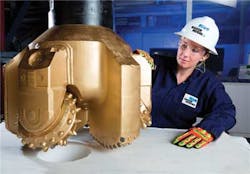Statoil, Baker Hughes run first large-diameter Kymera bit in Logan appraisal
Oct. 16, 2013
Baker Hughes has successfully deployed its Hughes Christensen Kymera hybrid drill bit for Statoil at an appraisal well in the Logan field, the first time a large-diameter Kymera bit has been run in the Gulf of Mexico.
A 26-in. Kymera hybrid bit with 19-mm cutters and premium metal face seals was used to drill the 26-in. vertical section through sediments and salt to section total depth, enabling 22-in. casing to be set 450 ft (137 m) deeper than the well's original objective.
The Kymera hybrid bit combines PDC and roller cone bit technologies for smoother drilling, superior torque management, and precise steerability through complex formations, according to Baker Hughes. The bit leverages the cutting and continuous shearing action of PDCs with the rock-crushing strength and stability of roller cones, providing improved performance, toolface control, and higher overall ROP for more footage than either a roller cone or PDC bit, the company says.
Statoil used Kymera bit and 26-in. AutoTrak X-treme rotary-steerable drilling system with CoPilot real-time drilling optimization and OnTrak measurement-while-drilling services in an attempt to improve drilling performance over what has been achieved by large PDC bits used in offset wells. Large PDC bits tend to generate high torque and vibration that can damage the bottomhole assembly and increase nonproductive time. Torque fluctuations also have limited PDC bits' ability to improve drilling performance in salt.
At the Logan appraisal, Statoil achieved an ROP of 57 ft (17 m) per hour through 1,995 ft (608 m) of salt, as well as 123 ft (37 m) per hour through 1,131 ft (345 m) of sediments. ROP improved by 26% compared to the nearest offset.
